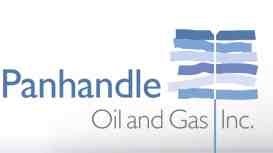
Panhandle Oil and Gas Inc. (NYSE:PHX), a non-operating independent oil and natural gas company with drilling projects in Anadarko Basin, Fayetteville Shale, and the Oklahoma Woodford Shales, does things differently from its oil and gas peers. It elects to own its mineral rights, but does not operate any of its oil & natural gas properties. Panhandle Oil and Gas Inc. (NYSE:PHX) is rewarded with a low cost structure and operational flexibility as a result of its differentiated business model and strategy. In addition, it is the least leveraged and most undervalued among its peers, which deserves a buy in my books.
Non-operating model responsible for low cost structure
Panhandle Oil and Gas Inc. (NYSE:PHX) does not operate any wells on its own; instead, it works with other large oil & natural gas exploration and production companies for drilling projects. That means that Panhandle typically only incurs drilling and operating costs, while others foot the bill for geological and geophysical costs. At the 2013 East Coast IDEAS Conference, Panhandle Oil and Gas Inc. (NYSE:PHX) also shared that it was ranked among the top five U.S. oil & gas companies with the lowest finding and development costs per BOE in 2012. Furthermore, Panhandle only has 20 full-time employees on its payroll.
Ownership of mineral rights gives it flexibility
Panhandle owns the rights of about 255,000 mineral acres itself, unlike most of its peers. Panhandle Oil and Gas Inc. (NYSE:PHX) has two options when it comes to utilizing its mineral rights. Under the first option, it chooses to participate as a working interest owner for wells where it deems it economically feasible (and rewarding) to participate, based on its analysis of the potential of the geological reserves. Under the second option, it takes a royalty interest in certain wells by leasing its mineral rights to other companies. In this kind of scenario, it trades off higher potential profits from a working interest for safer profits with limited liability and investments.
Excellent capital management practices
Firstly, Panhandle has not done any secondary offering in its company history. Frequent capital raising results in shareholders being allocated a decreasing share of the company’s value because of the increase in shareholder value created being offset by the increase in shares outstanding.
Secondly, although Panhandle’s forward dividend yield of 1% is not very significant, it has a track record of dividend payment spanning more than half a century. Dividends are backed by positive operating flow for every single year in the past decade.
Last but not least, Panhandle Oil and Gas Inc. (NYSE:PHX) has a strong balance sheet with a gross debt-to-equity ratio of 15.7%.
Peer comparison
Panhandle’s peers include Anadarko Petroleum Corporation (NYSE:APC) and Cabot Oil & Gas Corporation (NYSE:COG). Given that Panhandle has no analyst coverage; I use trailing P/E as a basis for valuation comparison. Panhandle is the most undervalued of the three with a trailing twelve months P/E of 40.
I view Anadarko Petroleum as relatively more risky than its peers. Firstly, Anadarko Petroleum Corporation (NYSE:APC) engages in a significant proportion of multi-year long-term projects which require huge capital outlays and have higher development risk. Secondly, Anadarko is engaged in exploration projects in certain African regions, which are relatively under explored and carry a higher chance of failure. This risk is partially mitigated by Anadarko Petroleum’s high deep-water exploration success rate of 67%.
Last but not least, legal and regulatory risks represent a bigger threat in certain emerging countries that Anadarko Petroleum Corporation (NYSE:APC) operates in. Ownership and tax-related disputes are among the common problems experienced with natural resource projects in such countries.
Cabot Oil & Gas Corporation (NYSE:COG) has key drilling operations in the Eagle Ford Shale in Texas, Marmaton oil play in Oklahoma, and Marcellus Shale in Pennsylvania. Cabot Oil & Gas Corporation (NYSE:COG) is exposed to a range of high return drilling opportunities, having identified about 3,000 locations in the Marcellus Shale, widely regarded as one of the most economic and large-scale resource plays in the U.S.
However, everything has a flip side. Legal & regulatory risk is a wildcard for any business and Pennsylvania is one of the hotspots for new oil & gas drilling regulations. In February 2012, Pennsylvania’s Oil and Gas Act was amended to introduce new restrictions on hydraulic fracturing, including an impact fee for drilling.
Conclusion
When investors come across natural resource companies or property developers/REITs, they tend to make their investment decisions by comparing the value of the hard assets with their share prices. I adopt a different approach, as I profess not to be an expert in valuing such assets. Instead, I look for companies with differentiated strategies focused on minimizing risks and maximizing returns.
For example, I prefer REITs which target acquisition in less crowded markets with weaker competing bidders. Along the same line of thought, Panhandle Oil and Gas Inc. (NYSE:PHX) is my preferred pick in oil & gas, because of its strategic focus on operational flexibility and low cost.
The article This Is Not Your Average Oil & Gas Company originally appeared on Fool.com and is written by Mark Lin.
Mark Lin has no position in any stocks mentioned. The Motley Fool has no position in any of the stocks mentioned. Mark is a member of The Motley Fool Blog Network — entries represent the personal opinion of the blogger and are not formally edited.
Copyright © 1995 – 2013 The Motley Fool, LLC. All rights reserved. The Motley Fool has a disclosure policy.




